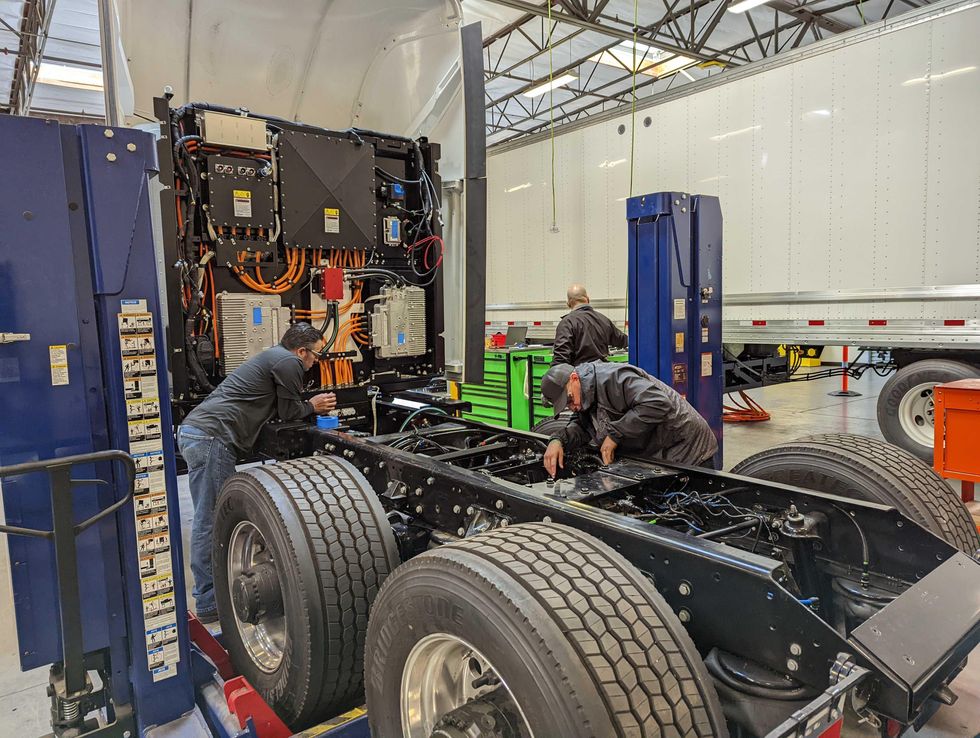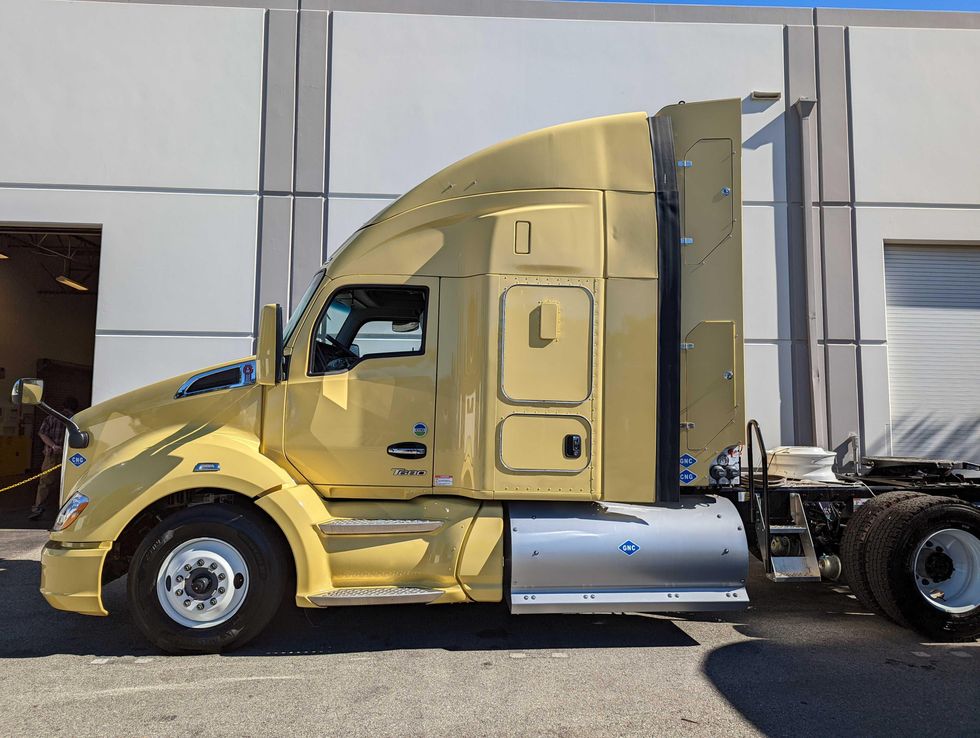'The Writing's on the Wall': Electric Batteries' Rapid Progress May Have Just Doomed Natural Gas Trucks
Last month, when dot.LA toured the Hexagon Purus facility in Ontario, California, multiple employees bemoaned the California Air Resources Board’s (CARB) ruling on renewable natural gas (RNG) as a hindrance to decarbonizing trucking-haul trucking. They argued that keeping RNG classified as a “near-zero emission” fuel prevented companies using financial incentives like the Hybrid and Zero-Emission Truck and Bus Voucher Incentive Project, which, as the name suggests, is only available to true zero-emission trucks. The effect, they said, was that the agency was missing an opportunity to accelerate the state’s transition away from diesel.
But over the weekend, Tesla CEO Elon Musk took to Twitter to announce that the EV company’s battery powered class 8 semi-truck had completed a 500-mile trip fully loaded (to the tune of 81,000 lbs). It now appears CARB’s refusal to classify renewable natural gas (RNG) as a zero-emission fuel source was ultimately the right decision.
Just two years ago Bill Gates famously declared that, “even with big breakthroughs in battery technology” electric vehicles were simply not ready to tackle long-haul trucking. If Tesla’s numbers hold up to scrutiny, it proves Gates and many other industry experts were likely wrong to suggest that “we need a different solution for heavy, long-haul vehicles.” And while 500 miles represents the lower limit for what’s necessary to transition long-haul transportation to battery power, Tesla’s announcement proves the tech is getting there.
What’s interesting is that the transportation sector saw the same arguments in the 2010s against passenger EVs. But then lithium-ion batteries underwent a small revolution where energy density gains outpaced even the most bullish predictions. And while such a surge in performance is unlikely to be repeated, even incremental gains on a truck with 500-mile range could cement the technology as the dominant energy source for the sector.
So what does this latest announcement mean for natural gas trucks?
As it currently stands, natural gas, in addition to hydrogen fuel cells, is still touted as a low- or even negative-carbon solution that could let the trucking industry slash emissions and get to net zero. In such a model, biowastes such as manure or plant scraps are harvested and converted into natural gas that can be combusted inside an engine. While this process does create CO2 as a byproduct, the amount of carbon saved by cleaning up the biowaste is often equal to or even greater than what’s created when the gas is burned. Industry insiders have often pointed to the fact that renewable natural gas can outperform alternatives from a greenhouse gas emissions perspective.
Tesla’s announcement also comes at a time when trucking giant Cummins recently showed off a new 15-liter natural gas engine design, which the company has advertised as a way for fleets to reduce their carbon usage and comply with California’s stricter nitrogen oxide emission requirements coming in 2024. Natural gas, the company has said, could once again be the “bridge fuel” that buys the industry time while hydrogen fuel cell and battery tech matured.
But outside of the trucking industry, environmental policy experts also seem increasingly confident that batteries represent the best chance for decarbonization. Colin Murphy, the deputy director of UC Davis' Policy Institute for Energy, Environment and the Economy, points to the fact that RNG is only carbon negative due to the credits it receives for reducing methane emissions.
Put another way, if California cleans up its methane problem anyway–as CARB has been proposing–there’s no sense in rewarding transportation companies for capturing and burning natural gas.
“If agriculture has to reduce their emissions in order to keep in line with the rest of the economy, they can't have this giant emission of methane out there that transportation is taking credit for,” says Murphy. “It's carbon negative for now, but it will not be carbon negative forever.”
Without the credit for capturing methane, burning natural gas is still 60% to 70% better than diesel in terms of greenhouse gas emissions, but compared to a battery charged from a grid that’s increasingly powered by solar, wind and other zero-carbon renewables, natural gas quickly loses much of its luster.
The same logic applies to RNG’s benefits to nitrogen oxide (NOx) emissions compared to diesel: They’re real, but they’re second best to actual zero-emissions tech like hydrogen and batteries. NOx pollution is generated in both diesel and natural gas engines and emitted at the tailpipe. While these chemicals don’t contribute as much to climate change as CO2, they create smog and air pollution that is a major health burden worldwide.
“These [natural gas] vehicles, they certainly are contributing to climate change, but they're much more closely tied to the local air quality,” says Patricio Portillo, a senior advocate for the NRDC’s Climate & Clean Energy Program. “And what we've seen, especially with natural gas vehicles, is that they don't really live up to the hype.”
Portillo notes that the vehicles receive their NOx ratings at the time they’re manufactured. But as the trucks age, components degrade and the actual amount of pollution they create increases.
“On the other hand, you are plugging into an increasingly clean grid with zero-emission vehicles,” he says. “So if anything, those things are just going to get cleaner over time, as the electricity grid continues to get cleaner.”
As CARB continues to drive policy with the state announcing a ban on new diesel truck sales by 2040, the transition to greener transportation will be a massive effort. To be clear, there is still a ton of work to do, on both the infrastructure side and on the supply chains needed to power such a massive undertaking. But at the moment, announcements like Tesla’s are increasingly looking like a signal that legacy truck makers and fleet owners would be wise to heed.
“If I'm a fleet looking at this, I think it's pretty clear that the writing's on the wall,” says Portillo. “It took some time for the technology to get there, but it's there now. It's not worth continuing to invest in second-best technology, because the result is going to be stranded assets for natural gas.”
- Can the Grid Survive the Coming Onslaught of Electric Vehicles? ›
- Hexagon Purus Places Multiple Bets on Electrified Trucking ›
- California Is Getting New Fueling Stations for Hydrogen Cars, But Who Will Use Them? ›



 The Californian branch of Norwegian parent company Hexagon Composites has recently set up an American branch in Ontario, CA, which is independently listed and focusing on zero-emission solutions to trucking. Photo by David Shultz
The Californian branch of Norwegian parent company Hexagon Composites has recently set up an American branch in Ontario, CA, which is independently listed and focusing on zero-emission solutions to trucking. Photo by David Shultz